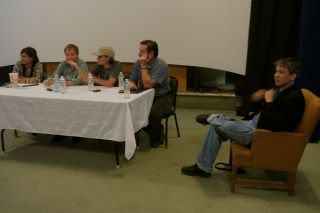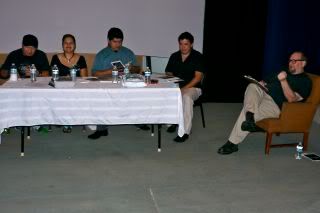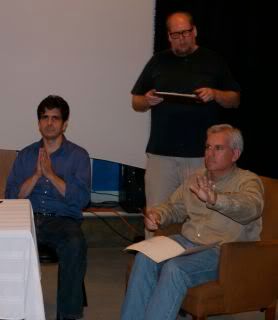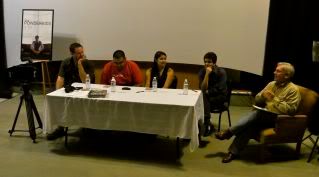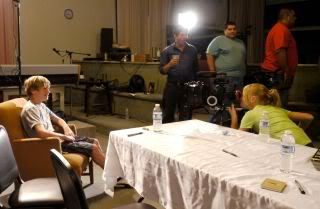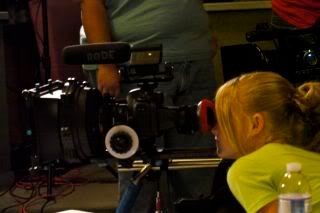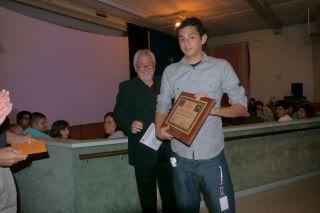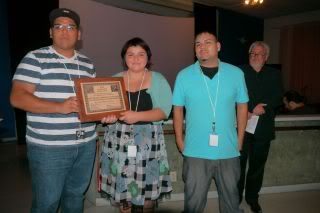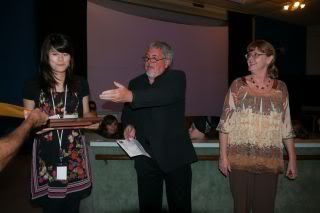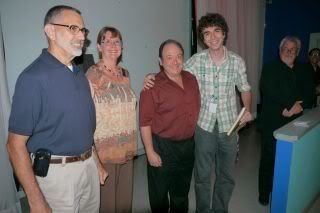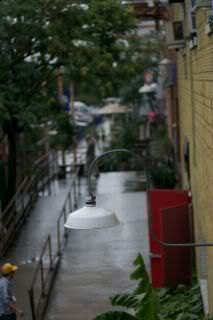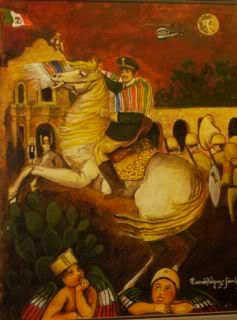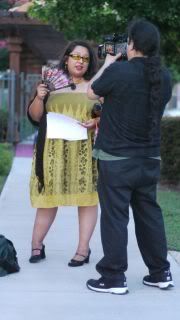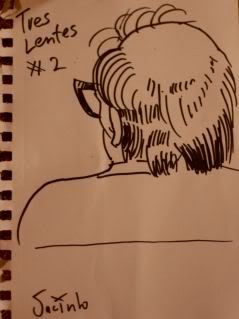[Friday.]
This week I’ve been opening C4 while Todd and Debbie are out of town on some sort of vacation. So I’ve been getting up damn early for me so that I can get the doors open by 8:30. In the morning. Oh, yeah, and walk the damn dog.
I only really need to be there until nine-thirty or ten when Key arrives. And, really, that’s enough time for me to listen to Democracy Now while getting some work done. This morning, while enjoying some cheap tacos from Benny’s on Roosevelt, I made a few changes to a press release as well as polishing up the previous blog. As for the press release, I sent a copy off to my sister–she’s a quick and impeccable editor.
Around noon I headed home and watched my newest delivery from Netflix. Jim Mendiola’s Come and Take it Day. This is a feature film he shot here in San Antonio in 2000 or 2001, before I arrived in town. It features Jesse Borrego. And, really, it’s a solid and engaging movie. I’m curious why I’ve not heard other people talk about it much. It’s not that Jim’s an ass or anything. He and his wife spend most of their time in Southern California, but they come back every few months. And, really, they seem to be universally loved.
I recommend it. It’s a very low budget work–a small and personal movie. But it has a nice pace. And it’s a smart script. It does a nice job of capturing the San Antonio I know and recognize.
After watching the film I checked my mailbox. Great! My external controller / timer / intervalometer had made its way to my mailbox.
It took me maybe thirty minutes to make sense of the overly simplified instructions. But it works a charm with my Panasonic Lumix GH1.
As I was trying to come up with a good test scenario, my sister called.
Thank god! She pointed out a couple of clunky stylistic problems, two or three typos, and an hugely embarrassing error where I had mistakenly replaced one famous name with another, similar famous name.
It’s good to have people watching your back.
@@@@@
I mounted my Lumix on one of my tripods. I attached my Nikkor 50mm lens with adapter. The composition was tight, intimate, and somewhat domestic. I opened the window above my sink which looks out onto the street. The sash weights were no longer working, so I was holding the window open with a bottle of honey. I had the aperture open all the way, and I decided to place the focus on a burnt-out match sitting beside a Mexican coin on the window ledge. The screen, the street, everything else was out of focus. I set my new remote device so that it would take a photo every five seconds–300 in all. I pushed the start button, and headed out on a bike ride.
For some reason the Mission Trail is seriously fucked up today. First, when I arrived at the area of Espada Dam, I was met with a barricade keeping me from proceeding on the trail. The wooden foot bridge over a creek feeding into the SA River was closed off for repairs. This means I had to take the low water crossing, which is a paved road for cars that crosses the San Antonio River. The spring rains have been so strong that the river has been running damn high. The paved road, as it crosses over the river, has been submerged under a couple of inches of water for over two months. I guess I’d go that way.
I enjoying taking the low water crossing when it’s dry because I can get some serious speed on the down slope, and that’s fun. But when it’s wet, I don’t care for how the water is kicked up by my rear wheel all over the back of my shirt. And that’s why I was going slow across the water. But, FUCK!, the submerged bit of pavement had grown a thick layer of moss or algae or something. It was insanely slippery. When I realized my front wheel was taking me quickly to the right, even though I’d not turned the handlebars, I realized what was up. I was damn lucky that when I got off and placed my feet on the road, I didn’t slip and land on my ass. I had to inch along, taking half steps. I really wonder how the cars manage when they cross. It was fortuitous that I was wearing sports sandals.
A short distance ahead, I saw some Park Police hassling a group of picnickers,
And a mile down the road, when I stopped to enjoy the cold water from the public fountain at Mission San Juan, I was rather dismayed that the water was shut off.
Not a good day for biking on the Mission Trail.
Back home, I pulled the SD card from my Lumix and dragged the files into my computer.
I had played games with stop motion and time lapse before, but I recently learned I was doing it all wrong and making things hard for me.
I placed my 300 photos into a folder. And then I fired up my QuickTime Pro (this comes bundled with FCP–you might have it and not know it). You get QuickTime to open the “Image Sequence” where the photos are. You can now play the sequence as a movie. That’s pretty cool. And you can then export a QuickTime movie, in the frame-rate and resolution you desire.
Here are two different ten second clips shot inside my place. Not much going on, but it’s just a test. Soon I want to start visiting downtown during sunrise as well as sunset so I can get some nice shadows racing across buildings. As basic and rudimentary as these two clips are, I’m intrigued with doing a series of small, quiet, domestic pieces–something like “the unseen life of an empty home.”
[youtube=http://www.youtube.com/watch?v=VHHjjtINMu0&hl=en_US&fs=1]
[youtube=http://www.youtube.com/watch?v=-5ERrtq4pPA&hl=en_US&fs=1]
@@@@@
[Saturday.]
The other day I was trying to look up information online about the shooting here in San Antonio of the film Viva Max! The sad thing about copyright issues is that one can’t, via the internet, get a solid overview of a subject, as many source materials are not available (and by that, I mean for free). Now I could get in my truck and drive to a library and, free of charge, research to my heart’s delight. But put the same information for free online? Fuck no! What a mess….
I did find an essay by Gary Cartwright, one of my favorite writers. It appeared in Life magazine back in 1969. Cartwright was describing the showdown between the production company for Viva Max! and the Daughters of the Texas Revolution. Now Cartwright isn’t above injecting a certain hyperbole into his work, and therefore I’m not sure just how accurate the piece might be. If Google is slowly becoming the source Of Record, it might behoove more writers and news agencies to begin providing their material absolutely free and as easily accessible as clicking a mouse.
Another interesting source was the website of Susan Ives, who is apparently involved with the San Antonio Peace Center. She quotes from Frank Thompson’s book Alamo Movies. Well, I think she quotes from it; however, she doesn’t use any discernible punctuation or formatting elements for me to be sure where her writing ends and Thompson’s begins.
I’m pretty sure that all the material below is in Thompson’s words. He’s describing a scene in San Antonio before the shooting of Viva Max! began:
Ustinov liked to tell the story of the official dinner that kicked off the production.
“One of the city fathers suddenly got up and said, ‘I should tell these fine visitors the true story of the Alamo.’ And I thought, ‘Oh, my God … ‘”
“And so we got the story of the Alamo and he ended by saying, ‘… and they drew a line in the sand, and do you know not one man crossed the line! They all perished!'”
“And I said, ‘Can I ask a question? If they all perished, how does the story come down to us?’
“There was a moment of embarrassment among the Texans and he said, ‘Well, now that you ask, there was one man did cross that line — a Frenchman, by the name of Rose.’
“I said, ‘Is that the origin of the Yellow Rose of Texas?’ Ahh … that was not the happiest of evenings.”
I must admit that I’ve not really looked too deeply into the Yellow Rose of Texas lore. It’s supposed that the song is about Emily Morgan (AKA Emily D. West), a “free woman of color.”
The Handbook of Texas online is, of course, a good starting point to read up on Emily:
http://www.tshaonline.org/handbook/online/articles/WW/fwe41.html
But I was more intrigued with this “cowardly” Frenchman. Moses Rose. Or, more accurately, Louis (Moses) Rose. And even though there were others who left the Alamo before the battle, such as Juan Seguin, Rose was the only one who left “after” Travis supposedly drew the famous line in the sand. Rose was apparently the only one who didn’t cross. He was allowed to sneak out a window at night. This melodramatic scene, which plays so heavily in Hollywood’s retelling of the story, comes from this lone witness.
There are some who maintain that the story of Travis drawing that line with his sword must be true. Why would Rose make up a story which would put him in such a poor light? The patriotic Texas narrative allows Rose to be a truthful man, though certainly a coward.
Personally, I think it’s time to make Moses Rose a hero. Perhaps next year, on March 3rd, I’ll promote a celebration–Moses Rose Appreciation Day. That’s the day he made his escape. He is quoted to have replied, in his later years, to the question, “Why didn’t you stay?” with the simple honest “By God, I wasn’t ready to die.”
I think we need to applaud those who decide to walk away from the battlefield, turning their backs on the insanity and immorality of war.
But that’s just me. I’ve never understood the concept of nationalism. Especially the extra creepy Texas nationalism. I’m with the Chicano revisionists who see that the sanctification of the Alamo is little more than taking an advocacy position of a bunch of anglo land speculators and filibusters who desired to carve out territory from a sovereign nation so that they could build a colonial state utilizing slave labor.
The irony–if we metaphorically extend this narrative–is that these anglo Texas “nationalists” of today are terrified, absolutely scared shitless, with this notion of outsiders coming into their territory. They know (perhaps more on an unconscious level) full well that their white Texas ancestors (whether they be related to them genetically or philosophically) were the illegal aliens of the Mexican state of Coahuila y Tejas. In a weak moment in Mexico’s economic and military history, the Texian’s wrested the land away from the still young independent Mexico. And, following the Civil War, the Texans were enraged by these northerners, these god damn carpetbaggers, coming down to tell them how to run their affairs. And this brings us to the present with this paranoia of illegal aliens. You see, there’s an historical precedent. Illegal aliens can indeed take over Texas. It’s happened before. These wetbacks (who may well have taken a tumble into the Red River or the Sabine or perhaps the Gulf of Mexico), these scofflaws of the laws of national sovereignty, have names well known to history: Travis, Houston, Bowie, Crockett, et al.
If it happened once, maybe it can happen again.
